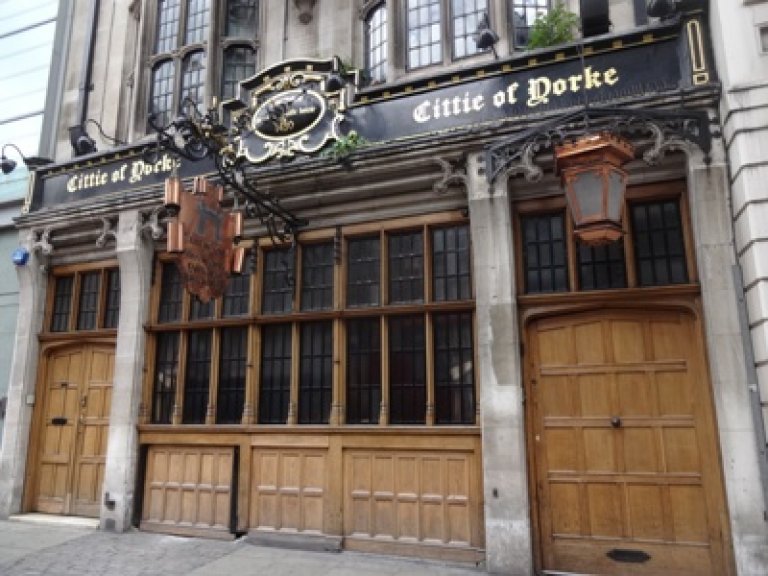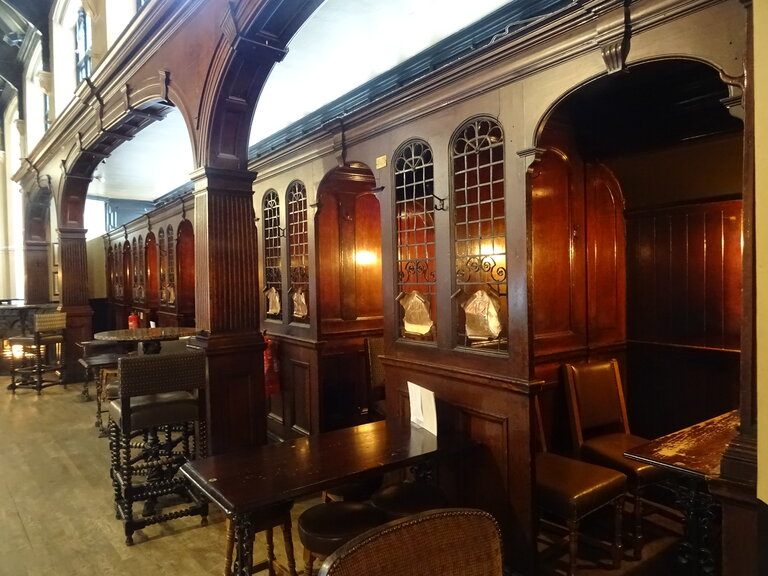Cittie of Yorke
22 High Holborn,WC1V 6BS
This pub is not only a grade II listed building, it is also a Three Star pub on the Campaign for Real Ale’s (CAMRA) National Inventory with an interior of outstanding national historic importance, and the description is as follows: "A truly remarkable pub. It was rebuilt in 1923-4 (possibly to designs by Ernest R. Barrow) and is a self-conscious, romantic evocation of an Olde England. Part of the nostalgic mythology of the world of drinking is the idea of good cheer and company in the medieval great hall or Tudor inn - such is what we have recreated here. Outside in the four-storey frontage we have Tudor detailing in the windows. The entrance is on the right and leads first to a panelled room of the type common in inter-war pubs and which evokes ideas of the late-sixteenth or early seventeenth centuries. The bar counter is a modern addition.
But what really counts is the long bar at the back which seeks to rediscover the atmosphere of the great English timber halls. This amazing room is unlike any other in a British pub. The roof is high-pitched and open, and at either end, at first floor level, are glazed-in upper rooms from which you might imagine the lord of the manor might keep an eye on the proceedings below. In fact the room at the far end is, less romantically, part of the manager's flat!
On the right-hand side is a resplendent three-bay arcade with clerestory windows above. Beyond is an aisle is filled with seven small carrels which serve as drinking booths (there are three more at the rear left); such features are to say the least rare in traditional English pubs (but similar to the compartments which are prominent in historic Northern Irish pubs). On the left-hand side the dominant feature is a formidable array of casks, some of enormous side and evidently of some antiquity (as are the cast-iron columns supporting the shelving). A high-level walkway stretches the length of the room. Splendid triangular stove with a flue escaping under the floor.
The direct connection to the front room is a modern addition - this room has painted roundels of famous figures from history and did have a modern bar counter until it was removed in 2010. The brick cellars from the previous building form the Cellar Bar, but this is only open when food is served so is closed in the afternoons and after 9pm. The special character of this pub is reflected in its being grade II listed. Closed Sunday."
The listing description is as follows: "Public house. Mostly of 1923-4, probably by Ernest R Barrow, replacing earlier wine shop of G Henekey and Co. Front faced in Portland stone with leaded lights, side and rear elevations of stock brick with wooden windows. Tiled roofs. Neo-Tudor style. EXTERIOR: 4 storeys and cellars. Front symmetrical, divided into 2 vertical units. Ground storey of front with doors at ends, centre with windows above timber base, slightly altered. Above, shallow bay windows left and right rising through 2 storeys and capped with string course carried on ornamental corbels, and then a third storey with single mullioned windows and terminating in parapet with 2 small enriched and shouldered gables. Large clock on ornamental bracket in centre between first and second storeys. INTERIOR: public entrance on right leading into wide passage with 4-centred timber arches and paved with flagstones. Front bar conventional with high panelled dado. Rear bar takes the form of a medieval-style hall running north-south with open timberwork and much dark woodwork, and lit from a clerestory and large bay window along east side. Below clerestory, 3 arches of uneven width with a series of snugs behind. On the west side the bar and above it a gallery on thin fluted cast-iron columns, probably Victorian, supporting casks and barrels of perhaps similar date, and above that again a high passage gallery for access to casks running the length of the room, partly supported from roof, partly by lower gallery and with wrought-iron handrail. Fittings include a freestanding triangular cast-iron ornamental stove fireplace with initials 'TIK', reputedly from Gray's Inn, c1815. HISTORICAL NOTE: an inscription on the fascia reads: 'Established as the site of a public house in 1430'. The present building retains few traces of pre-twentieth century work."
The WhatPub link is here WhatPub/Cittie of Yorke
The Pub Heritage Group link is here: PHG/Cittie of Yorke
The Cittie of Yorke featured on the Evening Crawl of Bloomsbury and Holborn on 4 August 2003, and the Evening Crawl of Bloomsbury and Holborn on 16 April 2008.




